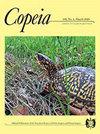Molecular Phylogenetics of the Clingfishes (Teleostei: Gobiesocidae)—Implications for Classification
IF 2.6
Q2 Agricultural and Biological Sciences
引用次数: 8
Abstract
Gobiesocidae are a moderate-sized family (currently 182 species, 51 genera) of predominantly coastal marine fishes, commonly referred to as clingfishes. Depending on the classification adopted, the species and genera of clingfishes are organized either across ten subfamilies, based on a classification scheme introduced in the 1950s (“traditional” classification, comprising Aspasminae, Cheilobranchinae, Chorisochisminae, Diademichthyinae, Diplocrepinae, Gobiesocinae, Haplocylicinae, Lepadogastrinae, Protogobiesocinae, and Trachelochisminae), or just two subfamilies, in a classification scheme adopted only recently (“reduced” classification, comprising Cheilobranchinae and Gobiesocinae). We investigated the phylogenetic relationships among members of the family Gobiesocidae using both mitochondrial and nuclear DNA sequence data to assess whether the alternative classification schemes (traditional and reduced) are compatible with inferred evolutionary relationships. Phylogenetic hypotheses are derived from maximum-likelihood and Bayesian analyses of a seven-gene concatenated dataset (2 mitochondrial and 5 nuclear markers; 4,857 bp) compiled from individuals representing 82 (of 182) species, 42 (of 51) genera, and 10 (of 10) subfamilies of the Gobiesocidae. Although our investigation provides strong support for the monophyly of the Gobiesocidae, multiple subfamilies of the traditional classification (Aspasminae, Diademichthyinae, Diplocrepinae, Gobiesocinae, and Trachelochisminae), one subfamily of the reduced classification (Gobiesocinae), and multiple genera (Aspasmichthys, Cochleoceps, Lepadogaster, and Lepadichthys) are resolved as non-monophyletic groups. Based on our results and the results of previous studies, we recommend a systematic reassignment of genera between subfamilies, of which we recognize nine: Cheilobranchinae, Chorisochisminae, Diademichthyinae, Diplocrepinae, Haplocylicinae, Gobiesocinae, Lepadogastrinae, Protogobiesocinae, and Trachelochisminae. Membership of the Lepadogastrinae is unchanged from previous usage; the Cheilobranchinae are expanded to contain additional genera from southern Australia, including those placed previously in the Aspasminae (Nettorhamphos and Posidonichthys) and the Diplocrepinae (Barryichthys, Cochleoceps, and Parvicrepis); the Aspasminae are placed in the synonymy of the Diademichthyinae and all genera placed in the former (excluding Modicus and Posidonichthys) are transferred to the latter; the Diplocrepinae are restricted to Diplocrepis; Eckloniaichthys scylliorhiniceps is transferred from the Gobiesocinae to the Chorisochisminae; Gobiesocinae are restricted to the New World members of this group (Acyrtops, Acyrtus, Arcos, Derilissus, Gobiesox, Rimicola, Sicyases, and Tomicodon); the Haplocylicinae are expanded to include additional genera from New Zealand (Gastrocyathus, Gastrocymba, and Gastroscyphus); the Protogobiesocinae are expanded to accommodate three genera of deep water taxa (Gymnoscyphus, Kopua, and Protogobiesox); and the Trachelochisminae are restricted to Dellichthys and Trachelochismus. Four genera (Aspasmogaster, Conidens, Creocele, and Modicus) of uncertain placement are not assigned to any subfamily herein and are considered incertae sedis within the Gobiesocidae.Clinfish的分子系统发育学(Teleostei:Gobiesocidae)——分类意义
Gobiesocidae是一个中等大小的科(目前182种,51属),主要是沿海海洋鱼类,通常被称为粘鱼。根据所采用的分类,抱鱼的种类和属可以分为10个亚科,这是基于20世纪50年代引入的分类方案(“传统”分类,包括Aspasminae, Cheilobranchinae, Chorisochisminae, Diademichthyinae, Diplocrepinae, Gobiesocinae, Haplocylicinae, Lepadogastrinae, Protogobiesocinae和Trachelochisminae),或者只有两个亚科,这是最近采用的分类方案(“简化”分类)。包括鳃鱼科和鳃鱼科)。我们使用线粒体和核DNA序列数据研究了Gobiesocidae家族成员之间的系统发育关系,以评估替代分类方案(传统和简化)是否与推断的进化关系兼容。系统发育假说来源于对7个基因串联数据集(2个线粒体和5个核标记;共4857 bp,共182种中的82种,51属中的42属,10亚科中的10亚科。虽然我们的研究为Gobiesocidae的单系性提供了强有力的支持,但传统分类的多个亚科(Aspasminae, Diademichthyinae, Diplocrepinae, Gobiesocinae和Trachelochisminae),简化分类的一个亚科(Gobiesocinae)和多个属(Aspasmichthys, Cochleoceps, Lepadogaster和Lepadichthys)被分解为非单系群。根据我们的研究结果和前人的研究结果,我们建议在亚科之间进行系统的属重新分配,我们确定了9个亚科:Cheilobranchinae, Chorisochisminae, Diademichthyinae, Diplocrepinae, Haplocylicinae, Gobiesocinae, Lepadogastrinae, Protogobiesocinae和Trachelochisminae。Lepadogastrinae的成员资格与以前的使用没有变化;Cheilobranchinae扩展到包括来自南澳大利亚的其他属,包括那些以前属于Aspasminae (Nettorhamphos和Posidonichthys)和Diplocrepinae (Barryichthys, Cochleoceps和Parvicrepis)的属;Aspasminae与Diademichthyinae是同义的,所有属于前者的属(不包括Modicus和Posidonichthys)都被转移到后者;双尾甲科仅限于双尾甲目;eckloniichthys scylliorhiniceps从Gobiesocinae转移到Chorisochisminae;Gobiesocinae仅限于该群的新世界成员(Acyrtops, Acyrtus, Arcos, Derilissus, Gobiesox, Rimicola, Sicyases和Tomicodon);Haplocylicinae扩展到包括来自新西兰的其他属(Gastrocyathus, Gastrocymba和Gastroscyphus);原gobiesocinae扩展到容纳三个深水分类群(Gymnoscyphus, Kopua和Protogobiesox);而Trachelochisminae仅限于Dellichthys和Trachelochismus。有4个归属不明的属(石绵螨属、孔螨属、Creocele属和Modicus属)没有归属于任何亚科,被认为是gobiesocides科中的intertae sesis。
本文章由计算机程序翻译,如有差异,请以英文原文为准。
求助全文
约1分钟内获得全文
求助全文
来源期刊

Copeia
生物-动物学
CiteScore
2.10
自引率
0.00%
发文量
0
审稿时长
6-12 weeks
期刊介绍:
Founded in 1913, Copeia is a highly respected international journal dedicated to the publication of high quality, original research papers on the behavior, conservation, ecology, genetics, morphology, evolution, physiology, systematics and taxonomy of extant and extinct fishes, amphibians, and reptiles. Copeia is published electronically and is available through BioOne. Articles are published online first, and print issues appear four times per year. In addition to research articles, Copeia publishes invited review papers, book reviews, and compiles virtual issues on topics of interest drawn from papers previously published in the journal.
 求助内容:
求助内容: 应助结果提醒方式:
应助结果提醒方式:


